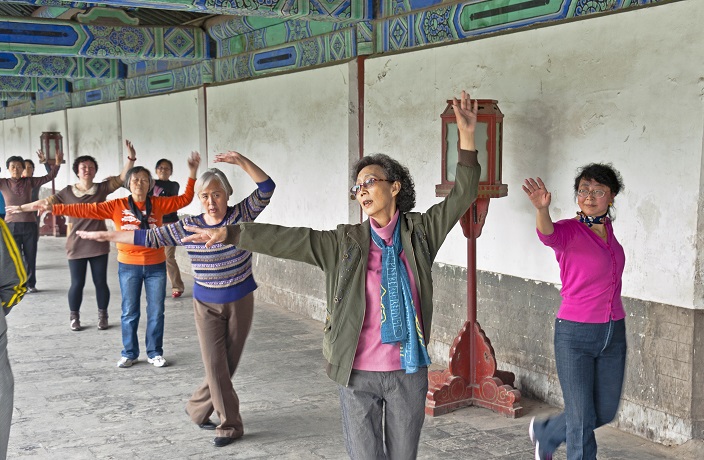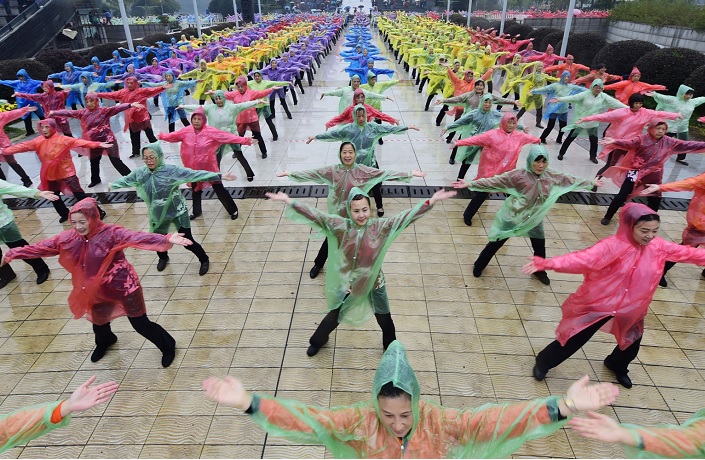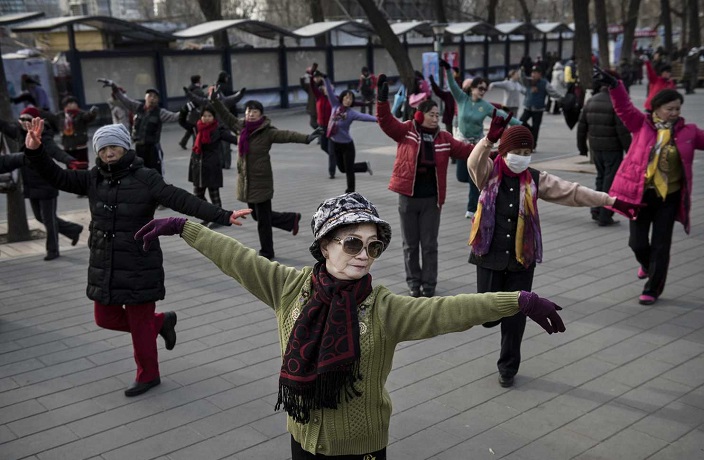Few have less reason to dance than the older women who flood China’s parks, pavilions and parking lots daily, occupying public spaces with shimmying bodies and ear-ringing music.
They are what one researcher termed “the first generation of lonely mothers” in China’s history; products of economic reform, social change and the one-child policy.
They are left with few social outlets, a limited family circle and no employment, while living in a nation radically different from the one they grew up in.
But to tech worker Vanessa Wu, 28, they are mostly just annoying. Wu doesn’t enter her bedroom until 10pm, when the music finally stops. It begins again in the morning, sometimes as early as 6.30am, echoing from the small square across the street where groups of women dance in front of speakers they wheel in twice daily.
“I get it. It’s their way of keeping up with friends,” says Wu. “It just doesn’t need to be so noisy.”
In the apartment building’s common room, Wu’s words are met with nods from other middle class 20-somethings.
The music and the dancers, estimated at 100-million strong by state media, rattle windows and nerves across China every day.
Often depicted as surly and self-centered, the dancers are mocked, disparaged and sometimes physically attacked. Yet they dance on.
“If we want to do something, we do it. If you don’t like it, you can f*ck off.”
Around 7.30pm, up to seven different dance troupes arrive in Huanggang Park in central Shenzhen. Filling the park’s wide pavilion, badminton games are slowly pushed into the street while the groups raise the volume of their speakers in a battle to be heard. Security guards look on.
“I’ll need a drink if I’m going to deal with their noise,” Nancy Lin, 23, says as she walks towards the park. “The dancers have become a sort of symbol. They represent retired women with money and nothing to do, while the rest of us are working hard, but have nothing.”
Lin found a job with HSBC in Guangzhou after studying in Oklahoma, the United States. About 235 million Chinese people are in the middle income bracket, according to a 2011 Pew Research Center study, and Lin will likely join their ranks. The divisions between dancers and despisers are often economic, according to Wang Qianni, the author of a study on the phenomenon.
“The middle class care about their private rights, such as wanting private space without others intruding. They also prefer quieter spaces. The dancers just think loud music is a happy thing,” says Wang. “It’s a matter of taste, and taste is related to one’s class, age and life experience. They are different from each other in these aspects. So the dance becomes a battlefield.”
Back at Wu’s place, she and her neighbors are clearly bothered by the nightly noise pollution, so why not just ask the dancers to drop a few decibels?
“You can’t really ask them peacefully to turn it down,” Wu says. “They will gang up on you.”
The square across from Wu’s apartment is about the size of a soccer field. About 12 dancers stand in formation, all facing towards a speaker and going through the same dance moves. After the group begins to disperse, some remain chatting with a plump 50-something woman in a red dress who has been leading them.
When we ask her why she dances, she gives the same guarded responses we will hear from all the other people we interview: it’s a hobby. It’s healthy. It’s innocent fun. It’s that simple.
“There just isn’t much to say,” the woman concludes. Her answers sound practiced and calm, but the smile drops from her face when we ask if the music could be affecting the neighbors. The mood of the group changes; some women walk away, but one steps forward and begins shouting.
“If we want to do something, we do it. If you don’t like it, you can f*ck off.”

Mass dance in China can be traced back thousands of years, likely beginning as a folk ritual and sometimes making appearances in royal courts.
But the seeds of today’s tensions may have begun in the mid-90s, when a perfect storm of societal changes hit the nation.
The World Bank estimates that only 19 percent of Chinese people lived in urban areas in 1980, but by 1995 that number jumped to 30 percent, a migration of 183 million people – or 40 million more than today’s Russia.
As cities across China filled, a restructuring of state-owned enterprises began in 1995, seeing an estimated 40 million jobs axed over seven years; that combined with a retirement age of only 50 years old for women.
In the past, these women would have dedicated their time to taking care of large families, but by the mid-90s the one-child policy had already been in effect for 15 years, leaving many single children with four people to care for them: two parents and four grandparents.
In short, there were a lot of idle, unemployed, middle-aged women adapting to life in cities.
“In the United States you have book clubs, religious activities,” says Wang. “While in China we have a dance culture.”
According to Wang’s research, many women grew up with dance in one form or another and cite a desire to exercise and socialize as a reason to begin again, but she also found that there are deeper forces at play. The woman are asserting their existence in a society they are losing touch with, while confronting Confucian norms that have reemerged since Reform and Opening Up began.
“Dancing in public challenges a persistent expectation – even more prevalent in rural areas – that females ought to focus their attention on household matters,” writes Dr. Tom McDonald, in an article on sapiens.org. “These attitudes persist and influence where women can go and with whom they can socialize.”
McDonald is an assistant professor at the University of Hong Kong and performed 15 months of research in rural Shandong Province, where he documented a dance troupe forming.
Speaking with us on the phone, McDonald explains that though superficially it might seem like a communal pastime, his study unearthed much more was at stake.
“In my case, they felt they were bringing something new and cosmopolitan into their village, and they feel that it is shifting the gender rules,” he says. “I think that we, as foreigners, tend to look at it with a kind of bemusement and think it’s quite funny and everything. It actually needs people to take it seriously. There is a lot of power and politics that goes on in these squares.”
Along with getting the women out in public, the dance had the unexpected effect of getting them onto the Internet, which became an integral part of the dancers' lives.
“One of the real things that came out of my ethnographic research was these women were using QQ to find and download music,” he says. “[The Internet] also helped them form a subtle support network. Sometimes if there are household problems, they can talk about it online, when it might be difficult to do it during their daily lives.”
A Baidu search for public square dancing videos turns up more than 20 million results (a search for tai chi videos turns up less than two million). Many of the videos are instructional or produced by independent troupes to show off their routines. Clearly, public dance has become an integral part of these women’s identities.

The mass migration to China’s cities has continued – the majority of Chinese citizens now live in urban areas – along with a growth of the middle class, who often have a very different idea of what a city should be than the generation before them. With the two disparate groups increasingly inhabiting the same space, the chance for conflict rises, with news reports regularly featuring stories about rows between the dancers and people who want to use the public space or simply live nearby.
Two of the most striking and widely reported incidents involving the dance troupes took place in 2013. In one, a man on the outskirts of Beijing, irritated by the noise, blasted his shotgun in the air before setting his Tibetan mastiffs on the dancers. In another, dancers were allegedly pelted with feces in Wuhan.
Despite the tensions, this November more than 50,000 Chinese dancers asserted themselves like never before in history, reportedly setting a Guinness World Record as they performed simultaneously in 14 cities across China, including Shenzhen, Shanghai and Beijing.
Images of the dancers, the vast majority women, show a tidal wave of matching red tracksuits, meant to draw attention to the health and welfare of retirees in China, according to the organizer, a company called Red Dance.
Back in Huanggang Park, a dancer, who asks not to be named, says she has been dancing for more than a decade and has no plans to stop.
“Of course we’ll be dancing in 10 years – it’s a hobby, just exercise. Nothing more.”
[Images via Huffington Post, CNN Money and Wikipedia]






















0 User Comments